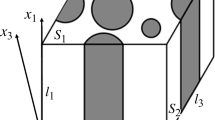Abstract
This paper deals with a two-dimensional generalized plane strain micro-mechanical model to simulate semi-coupled thermo-electro-elastic behavior of transversely polarized piezoelectric fibrous composites. The solution domain includes a representative volume element (RVE) consists of a long piezoelectric fiber surrounded by corresponding matrix in a square array arrangement. Fibers have orthotropic and/or transversely isotropic properties while are perfectly bonded to the isotropic matrix. In addition, the constituents are assumed to have linear thermo-electro-elastic behavior. The virtual form of equilibrium equations has been extended to cover the semi-coupled thermo-electro-elastic loading by using appropriate constitutive relations. The element-free Galerkin method is employed to discretize the governing equations in terms of three main primary variables including, displacements, electric potential and temperature. The performance of the present micro-mechanical study reveals close agreement compared with other techniques available in the literature. Based on the present study, ample results are addressed to provide an insight into the effects of the local fields, i.e. displacement, electric potential, electric field, and stress distributions within the RVE for the specific fiber volume fraction.


















Similar content being viewed by others
References
Schwartz MM (2002) Encyclopedia of smart materials. Wiley, Hoboken
Safari A (1994) A new local meshless method for steady-state heat conduction in heterogeneous materials. J Phys III 4(7):1129–1149
Li L, Zhang S, Xu Z, Wen F, Geng X, Lee HJ, Shrout TR (2013) 1–3 piezoelectric composites for high-temperature transducer applications. J Phys D Appl Phys 46(16):165306
Jayendiran R, Arockiarajan A (2013) Non-linear electromechanical response of 1–3 type piezocomposites. Int J Solids Struct 50(14):2259–2270
Jayendiran R, Arockiarajan A (2013) Investigations on non-linear temperature-dependent electro-mechanical response of 1–3 type piezocomposites. Int J Solids Struct 201:23–35
Lin X-J, Zhou K-C, Zhang X-Y, Zhang D (2013) Development, modeling and application of piezoelectric fiber composites. Trans Nonferr Met Soc China 23(1):98–107
Lv J, Yang K, Zhang H, Yang D, Huang Y (2014) A hierarchical multiscale approach for predicting thermo-electro-mechanical behavior of heterogeneous piezoelectric smart materials. Comput Mater Sci 87:88–99
Lin CH, Muliana A (2013) Micromechanics models for the effective nonlinear electro-mechanical responses of piezoelectric composites. Acta Mech 224(7):1471–1492
Lin C-H, Muliana A (2014) Micromechanical models for the effective time-dependent and nonlinear electromechanical responses of piezoelectric composites. J Intell Mater Syst Struct 25(11):1306–1322
Dai Q, Ng K (2012) Investigation of electromechanical properties of piezoelectric structural fiber composites with micromechanics analysis and finite element modeling. Mech Mater 53:29–46
Berger H, Kari S, Gabber U, Rodriguez-Ramos R, Bravo-Castillero J, Guinovart-Diaz R (2005) Calculation of effective coefficients for piezoelectric fiber composites based on a general numerical homogenization technique. Compos Struct 71(3):397–400
Berger H, Kari S, Gabbert U, Rodriguez-Ramos R, Guinovart R, Otero JA, Bravo-Castillero J (2005) An analytical and numerical approach for calculating effective material coefficients of piezoelectric fiber composites. Int J Solids Struct 42(21):5692–5714
Rodrıguez-Ramos R, Sabina FJ, Guinovart-Dıaz R, Bravo-Castillero J (2001) Closed-form expressions for the effective coefficients of a fiber-reinforced composite with transversely isotropic constituents-I. Elastic and square symmetry. Mech Mater 33(4):223–235
Bravo-Castillero J, Guinovart-Dıaz R, Sabina FJ, Rodrıguez-Ramos R (2001) Closed-form expressions for the effective coefficients of a fiber-reinforced composite with transversely isotropic constituents-II. Piezoelectric and square symmetry. Mech Mater 33(4):237–248
Sakthivel M, Arockiarajan A (2010) An analytical model for predicting thermo-electro-mechanical response of 1–3 piezoelectric composites. Comput Mater Sci 48(4):759–767
Sakthivel M, Arockiarajan A (2010) Thermo-electro-mechanical response of 1-3-2 type piezoelectric composites. Smart Mater Struct 19(10):105033
Levin VM, Rakovskaja MI, Kreher WS (1999) The effective thermoelectroelastic properties of microinhomogeneous materials. Int J Solids Struct 36(18):2683–2705
Mallik N, Ray MC (2003) Effective coefficients of piezoelectric fiber-reinforced composites. AIAA J 41(4):704–710
Ray MC (2006) Micromechanics of piezoelectric composites with improved effective piezoelectric constant. Int J Mech Mater Des 3(4):361–371
Kumar A, Chakraborty D (2009) Micromechanics of piezoelectric composites with improved effective piezoelectric constant. Mater Des 30(4):1216–1222
Kar-Gupta R, Venkatesh TA (2005) Electromechanical response of 1–3 piezoelectric composites: effect of poling characteristics. J Appl Phys 98(5):054102
Kar-Gupta R, Marcheselli C, Venkatesh TA (2008) Electromechanical response of 1–3 piezoelectric composites: effect of fiber shape. J Appl Phys 104(2):024105
Eynbeygi M, Aghdam MM (2015) A micromechanical study on the electro-elastic behavior of piezoelectric fiber-reinforced composites using the element-free Galerkin method. Acta Mech 226(9):1–18
Pettermann HE, Suresh S (2000) A comprehensive unit cell model: a study of coupled effects in piezoelectric 1–3 composites. Int J Solids Struct 37(39):5447–5464
Aghdam MM, Pavier MJ, Smith DJ (2001) Micro-mechanics of off-axis loading of metal matrix composites using finite element analysis. Int J Solids Struct 38(22):3905–3925
Cordes LW, Moran B (1996) Treatment of material discontinuity in the element-free Galerkin method. Comput Methods Appl Mech Eng 139(1):75–89
Belytschko T, Lu YY, Gu L (1994) Element free Galerkin methods. Int J Numer Methods Eng 37(2):229–256
Dolbow J, Belytschko T (1998) An introduction to programming the meshless Element Free Galerkin method. Arch Comput Methods Eng 5(3):207–241
Liu G-R, Gu Y-T (2005) An introduction to meshfree methods and their programming. Springer, New York
Liu G-R (2010) Meshfree methods: moving beyond the finite element method. CRC press, Boca Raton
Meitzler A, Tiersten HF, Warner AW, Berlincourt D, Couqin GA, Welsh III FS (1988) IEEE Standard on Piezoelectricity. ANSI/IEEE Std 176–1987. doi:10.1109/IEEESTD.1988.79638
Ahmadi I, Sheikhy N, Aghdam MM, Nourazar SS (2010) A new local meshless method for steady-state heat conduction in heterogeneous materials. Eng Anal Bound Elem 34(12):1105–1112
EBL Products Inc., Piezoceramic tubes for ultra-precise positioning applications. www.eblproducts.com
Author information
Authors and Affiliations
Corresponding author
Ethics declarations
Conflict of interest
The authors declare that they have no conflict of interest.
Rights and permissions
About this article
Cite this article
Eynbeygui, M., Aghdam, M.M. On the micro-mechanical study of 1–3 type piezoelectric composites with semi-coupled thermo-electro-elastic effects. Meccanica 52, 3693–3711 (2017). https://doi.org/10.1007/s11012-017-0656-7
Received:
Accepted:
Published:
Issue Date:
DOI: https://doi.org/10.1007/s11012-017-0656-7




